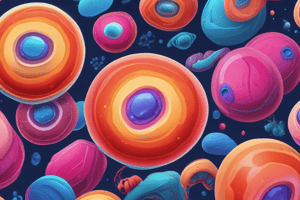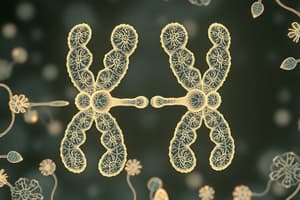Podcast
Questions and Answers
What is the main outcome of nondisjunction during meiosis?
What is the main outcome of nondisjunction during meiosis?
- There are always four viable gametes.
- Some gametes may have an extra or missing chromosome. (correct)
- All embryos produced are genetically normal.
- Meiosis can occur without errors.
Which chromosome's abnormality is associated with Down syndrome?
Which chromosome's abnormality is associated with Down syndrome?
- Chromosome 18
- Chromosome 15
- Chromosome 21 (correct)
- Chromosome 22
During which specific phase does the nuclear envelope remain intact until meiotic spindle formation begins?
During which specific phase does the nuclear envelope remain intact until meiotic spindle formation begins?
- Prophase I (correct)
- Anaphase I
- Metaphase II
- Telophase I
What is a significant factor that increases the risk of nondisjunction in meiosis?
What is a significant factor that increases the risk of nondisjunction in meiosis?
How many cells result from the two successive divisions of meiosis?
How many cells result from the two successive divisions of meiosis?
What is the main purpose of meiosis in sexually-reproducing organisms?
What is the main purpose of meiosis in sexually-reproducing organisms?
What distinguishes homologous chromosomes?
What distinguishes homologous chromosomes?
How many rounds of nuclear division occur during meiosis?
How many rounds of nuclear division occur during meiosis?
Which type of cell division is similar to meiosis II?
Which type of cell division is similar to meiosis II?
During which phase of meiosis does genetic recombination occur?
During which phase of meiosis does genetic recombination occur?
What is the ploidy level of the daughter cells produced at the end of meiosis I?
What is the ploidy level of the daughter cells produced at the end of meiosis I?
What is a characteristic of the chromosomes in a diploid nucleus?
What is a characteristic of the chromosomes in a diploid nucleus?
Which statement is true regarding meiosis I?
Which statement is true regarding meiosis I?
What happens during prophase I of meiosis?
What happens during prophase I of meiosis?
What is the role of the meiotic spindle during meiosis I?
What is the role of the meiotic spindle during meiosis I?
At the end of meiosis I, what is the ploidy level of each daughter cell?
At the end of meiosis I, what is the ploidy level of each daughter cell?
Which of the following statements about crossing-over is true?
Which of the following statements about crossing-over is true?
In which stage of meiosis do paired chromatids align along the equatorial plate?
In which stage of meiosis do paired chromatids align along the equatorial plate?
What is a characteristic feature of meiosis II?
What is a characteristic feature of meiosis II?
What is the first event that occurs in meiosis I?
What is the first event that occurs in meiosis I?
How many daughter cells are produced at the end of meiosis?
How many daughter cells are produced at the end of meiosis?
Flashcards
Meiosis
Meiosis
A type of cell division that reduces the number of chromosomes in the parent cell by half, producing four gamete cells.
Gamete cells
Gamete cells
Reproductive cells (sperm and egg) produced by meiosis.
Diploid
Diploid
Having two sets of chromosomes (one from each parent).
Haploid
Haploid
Signup and view all the flashcards
Homologs
Homologs
Signup and view all the flashcards
Autosomes
Autosomes
Signup and view all the flashcards
Meiosis I
Meiosis I
Signup and view all the flashcards
Meiosis II
Meiosis II
Signup and view all the flashcards
Sister Chromatids
Sister Chromatids
Signup and view all the flashcards
Prophase I
Prophase I
Signup and view all the flashcards
Crossing Over
Crossing Over
Signup and view all the flashcards
Metaphase I
Metaphase I
Signup and view all the flashcards
Haploid Cell
Haploid Cell
Signup and view all the flashcards
Cytokinesis
Cytokinesis
Signup and view all the flashcards
Nondisjunction in meiosis
Nondisjunction in meiosis
Signup and view all the flashcards
Down syndrome cause
Down syndrome cause
Signup and view all the flashcards
Meiosis nondisjunction frequency
Meiosis nondisjunction frequency
Signup and view all the flashcards
Meiosis duration
Meiosis duration
Signup and view all the flashcards
Meiosis divisions
Meiosis divisions
Signup and view all the flashcards
Study Notes
Meiosis Overview
- Meiosis is a cell division process that halves the number of chromosomes in a parent cell, producing four gamete cells.
- This process is essential for sexual reproduction, creating egg and sperm cells.
- The chromosome count is restored in the offspring upon the fusion of the sperm and egg.
Chromosome Structure and Function
- A sexually reproducing organism's chromosome set includes autosomes (common to all) and sex chromosomes (differentiated by sex).
- Diploid nuclei contain two similar versions of each chromosome (homologs).
- One homolog is inherited from each parent (maternal and paternal).
- Homologs are similar but not identical in DNA sequence, and usually remain independent chromosomes in most cells.
Meiosis Process
- Meiosis begins with a diploid parent cell (two copies of each chromosome).
- The parent cell undergoes DNA replication, followed by two nuclear divisions.
- The process culminates in four haploid daughter cells (half the number of chromosomes as the parent cell).
Meiosis I & II Differences and Similarities
- Meiosis I and II are distinct stages of meiosis.
- Meiosis I is unique to germ cells (cells that produce gametes).
- Meiosis II is similar to mitosis (produces two identical daughter cells from one parent cell).
- Meiosis I involves recombination (crossing-over) of genetic material.
- Meiosis II is a mitotic division of the haploid cells produced in meiosis I.
- Both stages involve multiple phases.
Key Concepts in Meiosis I
- Prophase I: Chromatin condenses into chromosomes, sister chromatids remain joined at centromeres. Pairing of homologous chromosomes (tetrads) and crossing over or recombination.
- Metaphase I: Homologous chromosome pairs line up along the equatorial plate.
- Anaphase I: Homologous chromosomes separate and move to opposite poles.
- Telophase I & Cytokinesis I: Chromosomes decondense, nuclear envelope reforms, and the cytoplasm divides, forming two haploid cells. The process takes a long time, particularly the prophase I step.
Key Concepts in Meiosis II
- Prophase II: Chromosomes condense, nuclear envelope breaks down, spindle forms.
- Metaphase II: Chromosomes align along the equatorial plate.
- Anaphase II: Sister chromatids separate and move to opposite poles.
- Telophase II & Cytokinesis II: Chromosomes decondense, nuclear envelope reforms, and the cytoplasm divides, forming four haploid cells. Each of these daughter cells contains half the full number of chromosomes as the parent cell.
Meiotic Errors
- Nondisjunction: Chromosomes fail to separate properly during meiosis, leading to abnormal numbers of chromosomes in gametes.
- This can result in conditions like Down syndrome (extra chromosome 21).
- Nondisjunction is more frequent in female meiosis, especially with increasing maternal age.
- Errors in meiosis frequently lead to miscarriages due to incomplete or missing chromosomes.
Additional Notes
- Meiosis does not involve DNA replication between the two divisions.
Studying That Suits You
Use AI to generate personalized quizzes and flashcards to suit your learning preferences.
Related Documents
Description
This quiz explores the essential concepts of meiosis, a process critical for sexual reproduction in organisms. It covers chromosome structure, function, and the steps involved in meiosis, emphasizing the significance of haploid gamete production. Test your understanding of these biological foundations.




